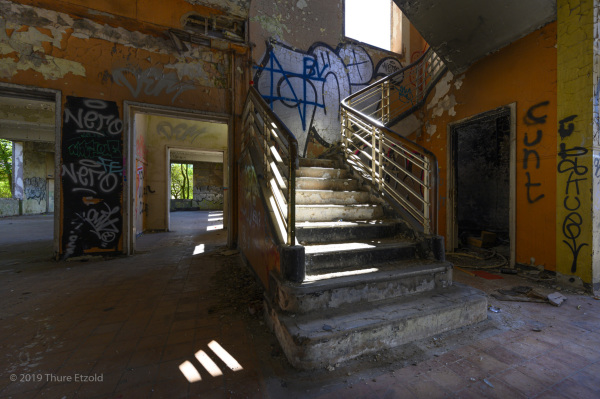Urbexing in Cambridgeshire
Urbexing meant nothing to me until a friend suggested we give it a try. It’s the exploration of man-made structures, preferably abandoned. Photography is an essential part of it as is, in most cases, trespassing.
Our first target was an old rectory. Deserted for about twenty years, it was so far gone that we had to be very careful walking inside. The roof was dotted with large holes, floors had fallen in, the main staircase had rotted away and loose floor boards and radiators were precariously looming above our heads. Despite the hot and sunny weather, the air was thick with moisture. The house had turned into a biotope for fungi and algae, and tendrils from plants in the garden were reaching inside. To create a focus point and to add an element of splendour to the festival of gloom and decay, I brought a bunch of roses.

Next up was an abandoned RAF airbase that had for several decades suffered the slow death of diminishing use. After the site was finally shut down, five years ago, hordes of vandals took over, smashing windows and doors, setting fire and spraying graffiti with lustful abandon. The result is a glorious symphony of textures and stages of dilapidation in which graffiti plays centre stage—clearly it has become an integral part of post-industrial decay.

For me as a photographer the lure of ruins is largely about the textures that are at play with each other. But that’s not all. I feel I’m part of a world-wide movement for the appreciation of urban decay, not just of ruins but of the whole world in tatters as evidenced by a burgeoning number of dystopian novels, films and computer games.
But why is that? Do we feel that we live in a dystopian world already and seek its betterment by comparison, similarly to the way we are strangely comforted by watching people in desperate circumstances?
Some say that the appeal is paradoxical. Ruins are both pointing to the past and the future as they are remnants of a vanished world and a sign of things to come. Others say that they induce the melancholic experience of loss that gives us a form of satisfaction. Or is it the curious psychopathology of being drawn to what we fear most, an experience like vertigo, the conflict between the fear of falling and the desire to fall?
Perhaps our psyche is still largely that of cavemen. Despite spending most of our time in immaculate rooms with flat and even surfaces, we cannot, deep down, accept them as our natural habitat. Dereliction is the process that restores these aberrations to something closer to nature. It removes the offending straight lines and square angles. Uniformity and evenness are repaired by the application of water, frost and mould, and if that is true, how can it not be satisfying to watch?


























